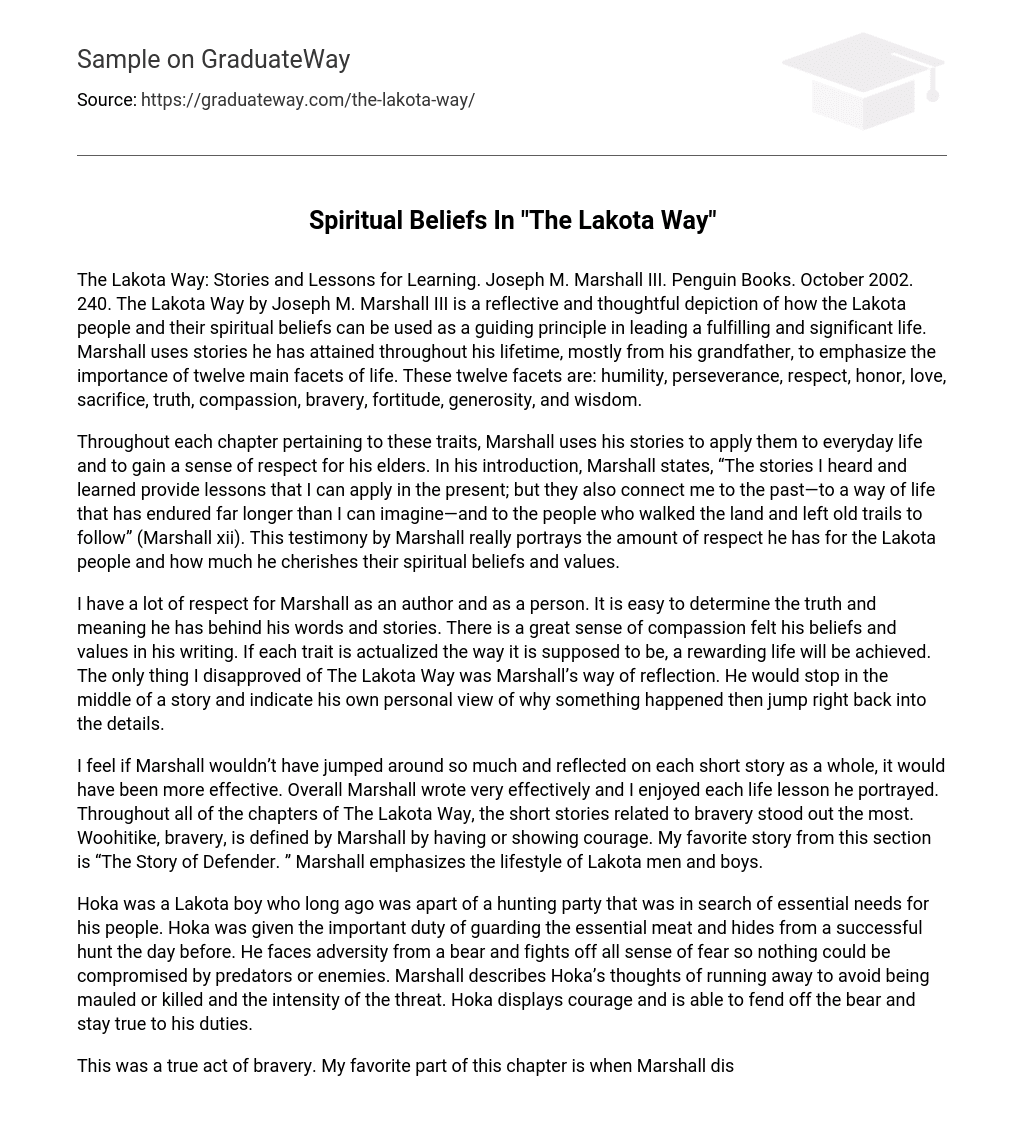The Lakota Way: Stories and Lessons for Learning. Joseph M. Marshall III. Penguin Books. October 2002. 240. The Lakota Way by Joseph M. Marshall III is a reflective and thoughtful depiction of how the Lakota people and their spiritual beliefs can be used as a guiding principle in leading a fulfilling and significant life. Marshall uses stories he has attained throughout his lifetime, mostly from his grandfather, to emphasize the importance of twelve main facets of life. These twelve facets are: humility, perseverance, respect, honor, love, sacrifice, truth, compassion, bravery, fortitude, generosity, and wisdom.
Throughout each chapter pertaining to these traits, Marshall uses his stories to apply them to everyday life and to gain a sense of respect for his elders. In his introduction, Marshall states, “The stories I heard and learned provide lessons that I can apply in the present; but they also connect me to the past—to a way of life that has endured far longer than I can imagine—and to the people who walked the land and left old trails to follow” (Marshall xii). This testimony by Marshall really portrays the amount of respect he has for the Lakota people and how much he cherishes their spiritual beliefs and values.
I have a lot of respect for Marshall as an author and as a person. It is easy to determine the truth and meaning he has behind his words and stories. There is a great sense of compassion felt his beliefs and values in his writing. If each trait is actualized the way it is supposed to be, a rewarding life will be achieved. The only thing I disapproved of The Lakota Way was Marshall’s way of reflection. He would stop in the middle of a story and indicate his own personal view of why something happened then jump right back into the details.
I feel if Marshall wouldn’t have jumped around so much and reflected on each short story as a whole, it would have been more effective. Overall Marshall wrote very effectively and I enjoyed each life lesson he portrayed. Throughout all of the chapters of The Lakota Way, the short stories related to bravery stood out the most. Woohitike, bravery, is defined by Marshall by having or showing courage. My favorite story from this section is “The Story of Defender. ” Marshall emphasizes the lifestyle of Lakota men and boys.
Hoka was a Lakota boy who long ago was apart of a hunting party that was in search of essential needs for his people. Hoka was given the important duty of guarding the essential meat and hides from a successful hunt the day before. He faces adversity from a bear and fights off all sense of fear so nothing could be compromised by predators or enemies. Marshall describes Hoka’s thoughts of running away to avoid being mauled or killed and the intensity of the threat. Hoka displays courage and is able to fend off the bear and stay true to his duties.
This was a true act of bravery. My favorite part of this chapter is when Marshall distinguishes bravery can be displayed in other ways than facing the possibility of death. Bravery however needs to be taken in context, because life itself demands it in many ways. At the end of this section, Marshall states, “Being brave is having or displaying courage during hardship, being strong in the face of pain” (Marshall 157). No matter what life throws at you, showing courage is the first step to overcoming any adversity.
Understanding and representing this trait, is a very powerful quality and will lead one to acquiring a meaningful and ethical life. Aside from the section of bravery, there are two other statements made by Marshall that has really stuck with me. In perseverance chapter, Marshall states: You can’t truly succeed without perseverance. If you’ve easily accomplished many goals, you are indeed fortunate. But as my grandfather would often say, life isn’t worth living unless you are forced to defend it now and then.
Therefore you haven’t truly tasted success unless you’ve picked yourself up after failure has knocked you down, as many times as it takes, until you accomplish what you’ve set out to do. (Marshall 35) This statement is all-powerful. Marshall adds so much emphasis to this trait because when it is exemplified, obstacles in life become easier and easier to overcome. Finally, in the last line of this book, Marshall states, “When all is said and done, I would prefer to be known for my wisdom. I would like to be remembered as one who reciprocated life’s gift” (Marshall 205). This line shows how important the power of wisdom is to Marshall.
Out of all twelve traits expressed throughout his stories, wisdom is the one in which someone can repay the gift of life. If one is wise they will be able to maximize their life’s value. Overall, this book was a very good read. The lessons and stories portrayed in The Lakota Way by Joseph M. Marshall III are very compelling. If one wants to live life to it’s fullest potential, fulfilling these qualities is the way to go. His impressive story telling ability really puts the rewards of these traits into perspective and gives an incentive to live life the way it is supposed to.





